Read Reviews
The Best Insect Hotels
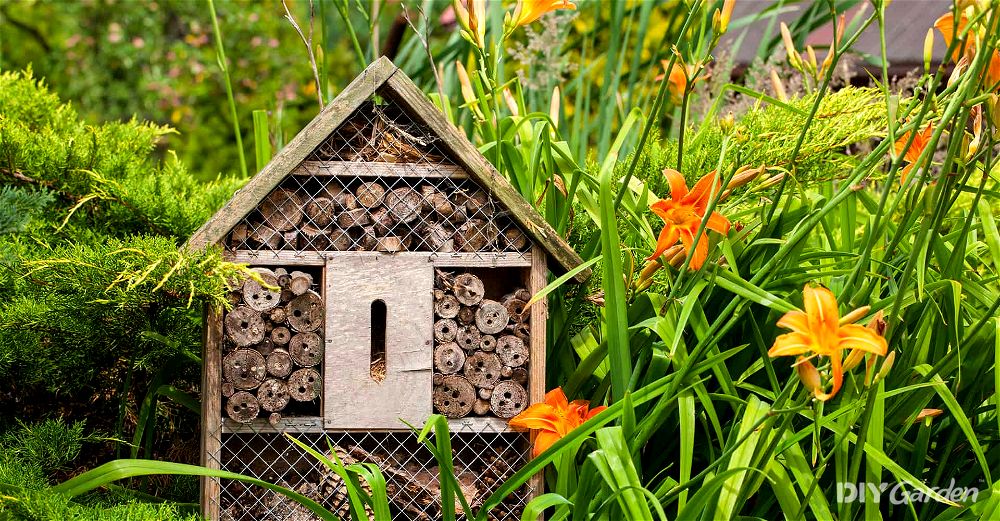
-
Woodside Wooden Insect Hotel & Bee House
-
Nature's Market Insect and Bee Hotel
-
Heritage Fix On Insect Hotel
-
Aubry Gaspard Large Wooden Insect Hotel
-
Selections Wooden Castle Insect Hotel
Insect Hotel Reviews
- Can become a popular habitat for bees to create nests
- Easy to hang and comes with all the necessary fittings
- Suitable for smaller gardens because it can be hung on a fence or wall without taking up floor space
- Offers good value for money in terms of price and workmanship
- Some of the bee-burrows may not be drilled deep enough on arrival and require further drilling
- Occasionally there can be some rough edges which may need sanding down
- As there is no roof overhang at the front, the habitats may get wet
Even if you’ve only got a small area of wall or fence in the garden, or just a wooden mounting post, this Woodside Wooden Insect Hotel is compact enough not to take up a lot of space, whilst still offering a decent variety of bug habitats
It measures 37 x 26 x 11 cm and comes with fittings included to hang it in the garden. Alternatively, it can free-stand on the grass or a on top of a low wall.
Four different habitats are offered: there’s bamboo and logs with drilled holes for bees; slits in wood for butterflies; pinecones for green lacewings; and assorted loose wood for everything else. The loose pieces are safely concealed behind wire mesh to stop birds and squirrels pulling out your new hotel guests.
Customers have reported a lot of success with bees coming to nest, so it’s clearly an attractive hotel for insects (as well as for humans to look at!). It needs to be carefully positioned, preferably east/south-east facing to catch the morning sun but be in shade for the end of the afternoon. This will create the most appealing environment for bugs.
Overall, it is quite well made, and is one of the best insect hotels offering value for money; it’s relatively inexpensive, yet suitably designed and easy to position. In some instances, customers have chosen to drill deeper holes, and sand down rough edges, to improve the conditions for insects, so there may be some areas were quality is lacking.
Did you find this review helpful?
- Easy to hang and could be used on balconies
- Good budget option for anyone who is intrigued but isn't sure whether they'll have success with a bug hotel
- Small size is suitable for compact spaces and gardens
- Design can vary quite a lot from the pictured model
- Not very many bamboo canes for nesting bees
- If hotel swings in the breeze this may put off insects
For small gardens, balconies, or patios, this Nature’s Market Insect and Bee Hotel is a compact option that’s easy to hang.
With a rustic wooden design, including a slatted roof and frame bordered by imitation moss, it has a subtle appearance that won’t look overbearing in a small space. Overall, it measures 14 x 16 x 15 cm making it the most compact option on this page.
There are holes drilled into the wood, and bamboo canes, to help attract nesting bees; the only problem with this hotel’s size is that there aren’t as many holes or bamboo burrows as with other models.
In fact, even the display photo can be a little misleading, as the hotel often comes with much fewer bamboo canes than the model pictured.
Nevertheless, it’s an inexpensive option, and one of the best insect hotels available on a budget. It’s probably best suited to use in small areas where you’re hoping to attract some insects, but don’t want to break the bank in case none show up.
It comes with a wire hook, but could also be wall mounted with a bit of DIY initiative; it should be hung in a way that limits how much of a breeze can blow through the holes as this will put insects off.
Did you find this review helpful?
- Relatively easy to affix to a fence or tree
- Sturdy construction feels well made
- Colour and design are complementary in the garden
- Some of the sections may arrive with less filling than shown in the pictures
- You may have to supply some of your own fixings in order to properly attach to a fence/tree
With a variety of insect-attracting media included, the Heritage Fix On Insect Hotel is designed for attracting bees, butterflies, ladybirds, lacewings, beetles and any other insect that fancy taking up lodgings inside.
There are four different habitats included: bamboo and drilled wood for bees, wooden slits for butterflies, and pinecones and loose wood for various other bugs.
Comparing the price with other insect hotels on the market, this model offers good value considering its size and the number of sections included. It’s one of the best insect hotels for trying to attract a large variety of bugs, without having to buy a larger, more expensive model.
Measuring 33 x 27 x 10 cm, this hotel can be attached to a fence or tree without taking up too much space. It needs to be mounted as there is no way to hang it, and should ideally be fixed facing southwards to encourage different insects.
The design can vary somewhat from the pictures, with customers receiving differing amounts of habitat media in each section; this factor can lead to some variation in quality between different versions of the same product and is something to be aware of.
Overall, it gives off quite a rustic feel and has a unique shape which will add a bit of interest to any wildlife garden; plus, there are reports from customers of bees moving in relatively quickly – so it can clearly be a hit with the wildlife.
Did you find this review helpful?
- Seven separate sections catering to different types of insects
- A variety of nesting materials used to encourage as many bugs as possible
- Large size means that it can cater to a lot of different animals
- Slanted roof designed to protect from and back from water run off
- No assembly required as comes in one piece
- May be too wide and deep to fit into smaller gardens
If you’ve got a lot of space in the garden, or are keen to dedicate a whole corner to bugs, this Large Wooden Insect Hotel offers an impressive number of habitats.
There’s essentially a habitat for every insect going, and it’s large enough to create an aesthetically-pleasing focal point in any wildlife garden. Plus, due to its size and numerous nooks and crannies, it’ll capture the kids’ imagination too.
It’s made from wood and has a slanted roof to help with water run – protecting the insects from cascades of rain. The hotel is split into seven sections, with each one containing a different nesting material.
There are pinecones for ladybirds, wood slits for butterflies and moths, bamboo canes for solitary bees, and loose pieces of wood for any beetles that fancy a new abode. Undeniably, quite a lot of potential wildlife could make itself at home in this insect hotel.
As mentioned, it is quite large – so this is really the only potential downside. It requires quite a lot of space, measuring 100 cm tall by 62 cm wide by 16cm deep, and therefore might not fit into smaller gardens. It would be best placed up against a wall, and that way it can be secured to prevent any toppling over.
The wide feet help keep the main body off the damp ground, which will help limit rot from damaging the frame of the hotel. You could even push bricks against the feet to keep the bug hotel upright, which would also encourage woodlice and maybe even frogs – animals that enjoy cool stone conditions.
Overall, this is one of the best insect hotels if you want to attract the most bugs possible. Due to its large size it will be fascinating to keep an eye on in the different seasons, and make a statement in the garden. It comes fully assembled too so there are no worries about fixing it together.
Did you find this review helpful?
- Well made resulting in a sturdy product
- Aesthetically charming design that appears to children
- Bug hotel design elements thoughtfully combined with castle design
- The finish isn't always very smooth and some rough edges may need sanding down
Whilst all insect hotels are aesthetically interesting in their own right, this Wooden Castle Insect Hotel has an extra element of fun going for it – incorporating a castle-shaped fortress into its design.
Holes in the wood, designed for bees to nest, look like windows in the castle, whilst the protective metal grating over the loose-wood section resembles a portcullis. There are even gaps in the wood for butterflies, made to look like the castle’s arrow slits.
All of these factors offer a fun way to introduce kids to the world of insects and bugs in a visually interesting way. There are three habitats incorporated into the build in total – which arguably isn’t as many as with most insect hotels this size – as there are no pinecones included with this model.
Measuring 32 cm tall by 27 cm wide and 8 cm deep, it’s large enough to get a good view of what’s going on without being too big. It can be hung on the wall, with two hooks included for hanging over nails, or stood on a flat surface in the garden.
Overall, this is one of the best insect hotels for encouraging kids to get involved with wildlife in the garden; it’s visually entertaining and may be more inspiring than basic models. These factors could inspire children to be more interested in checking for bugs.
Furthermore, what could be more enchanting than having a little mini castle nestled away in the garden (even if you don’t have kids)!
Did you find this review helpful?
How to Choose The Best Insect Hotel
Insect hotels are a great way to attract a diverse range of bugs to your garden.
Not only are they fascinating to look at, but it can also be very beneficial to have pollinating insects around.
Most insect hotels cater for bees, and then may have additional sections for different insects. However, designs can vary, so it can be good to know what to look for to make sure you get exactly what you need.
The following information has been put together to shed some light on the different designs and specifications of insect hotels on the market:
Attracting Different Insects
If your bug hotel has several different nesting sections/‘habitats’, you should be able to attract different types of insects.
Here are some of the different bugs you might want to attract, and what sort of material they will be looking for:
Solitary Bees
There are actually more solitary bees in the UK than bees that live in colonies.
Solitary bees often look for tunnels in which they can nest and lay their pupae. Therefore, if you’re hoping to attract bees, you should choose a bug hotel with drilled wood (tunnels drilled into wood) and bamboo canes. These provide an ideal habitat for nesting solitary bees. Of course, spiders also enjoy these kinds of dark environments, so you may have to make sure that all of the tunnels don’t get filled with cobwebs.
Positioning the insect hotel so that it faces south/southeast will increase your chances of attracting insects like bees. It’s good if the hotel receives sun in the morning, but shade later in the afternoon.
READ NEXT: How Bees Ensure Our Survival
Butterflies and Moths
When butterflies hibernate, they like to crawl into small cracks which give them shelter. During bad weather, such as rainstorms, butterflies and moths will also take refuge in similar small crevices. To help offer them a sheltered environment, consider an insect hotel that has several wooden slits. This will allow both butterflies and moths to crawl inside, tucking their wings away, and offer protection from the elements.
READ NEXT: How to Prevent Butterflies Declining
Beetles and Spiders
Beetles and spiders like dry, dark environments. Loose material like dry leaves and pieces of wood create good habitats. Try to make sure that these areas are concealed behind something, like a metal mesh guard, so that insects can get in but birds can’t. Otherwise, birds can get wise to the idea of the insect hotel being an easy food source – not the intended plan!
Ladybirds
Adult ladybirds hibernate over winter, and also hunt out safe places to lay their eggs. Generally, they look for dry, woody environments. This sort of habitat can be replicated through the use of pinecones, which ladybirds like to hide and nest amongst.
Too Much of a Good Thing?
Although multiple sections in an insect house can attract different species of insect, they also make it easy for disease and parasites to spread.
Whilst it might seem unnecessary, it’s generally recommended to clean out a bug hotel at least once a year – particularly to help with bee health. There’s more information on how to properly go about this in the next section.
Taking Care of Your Bug Hotel
Bug hotels need a bit of upkeep in order for insects to keep coming back. In particular, cleaning out the bee tubes once they have been vacated is important. If these spaces aren’t cleaned, future bees won’t move in.
Cleaning them out once a year is enough, and often summer is the best time to do it – by this point any eggs should have hatched and the bees emerged. Of course, you should be mindful not to disturb any bees that have not vacated their nest yet.
Use warm water and a small bottle brush or pipe cleaner to clean the tubes.
You should also replace the nesting materials every couple of years to make sure that they are not rotting or going mouldy.
Bug hotels are made of untreated wood, because treated wood isn’t as appealing to insects; therefore, they are much more prone to rot and damp than other wooden garden items. This may mean that they need to be replaced after a couple of years. Also, you shouldn’t treat or paint the insect hotel, as the solvents and chemicals won’t be good for wildlife.
Some people suggest moving the bug hotel into a shed over winter so the inhabitants keep dry and experience steadier temperatures. If you’ve bought a pricier insect hotel, this idea may appeal as it will extend the hotel’s life, just remember to put it back outside in very early spring.
You can also extend the life of a bug hotel by keeping it in a sheltered place away from rain and prevailing wind. Next to a fence, hedge, or under a tree are all good spots.
Bee hotels benefit from a slate roof with some overhang, but you should avoid covering any insect hotel with plastic sheeting or tarpaulins.
READ NEXT: How to Build Your Own Bug Hotel
Quality Design
A solid bug hotel, which keeps out drafts and damp, will attract bees and butterflies, ladybirds and lacewings. A damper environment will attract wood-eating insects such as woodlice and earwigs.
Encouraging a range of insects is beneficial for the environment, but make sure they can all access the bug hotel.
Woodlice and earwigs can’t fly to the top but they can creep into lower sections. Bees and butterflies will happily make their way to the dry and warmer top sections without assistance.
If your bug hotel is standing, the inclusion of legs can keep damp from creeping up and causing rot. If it’s hanging, try to make sure that it hangs against a fence or tree, so that it is not swinging. A bug hotel that is constantly moving will not be as appealing to insects.
As mentioned, you should ensure no preservatives or stains have been used as bugs don’t like them. Also, make sure the nesting materials are not glued into place as these should be refreshed each year.
READ NEXT: Latest Bee Population Decline Statistics
Insect Hotel FAQs
Whilst bug hotels may get a few visitors no matter where they’re placed, location is still important to get the most out of your investment.
If your bug house has a habitat for bees, it should be placed at a height of at least one metre. It should also be positioned to face in a south/southeast direction. This is because bees appreciate the warmth of the morning sunshine and the protection of the afternoon shade. There should be no vegetation blocking the entrance, and it should be generally sheltered from rain and wind as much as possible.
If you’re looking to attract other insects, most of them prefer a slightly damper, shaded environment. Consider choosing a sheltered area of the garden – preferably near an insect-dense area like a hedge, compost heap, fruit tree or wildflower garden.
If nothing moves into the insect hotel, despite your best efforts, try moving it to a more sheltered/damper spot. Plant some wildflowers nearby, leave some old wood to rot down, and allow the grass to grow long. Also, if you’re using pesticides in the garden – stop!
A bee hotel will attract solitary bees like the mason bee and the leaf cutter. A hotel with slits for butterflies will attract overwintering species such as brimstone, comma and red admirals.
Loose dry leaves, pine cones, wood, straw, damp wood, and stones attract a lot of different insects. These include ladybirds, lacewings, hoverflies, moths, spiders, woodlice, beetles, earwigs, centipedes, millipedes, shield bugs, and all their larvae.
You can encourage all types of insect with plants like buddleia, lavender, campanula, dandelion, hellebore, sedum, jasmine, honeysuckle, erica, and mahonia. Dead wood piles and long grass are a good way to bring in the beetles.
Insect hotels can be put out at any time of year. Bugs tend to think about hibernation during the autumn months but they always need shelter and protection from the elements and predators. Many insects lay their eggs in spring, so during this time you may have bugs using the hotel to nest. If insects don’t move in right away, leaving the hotel outside will allow it to weather down a little which may encourage them to do so later on.
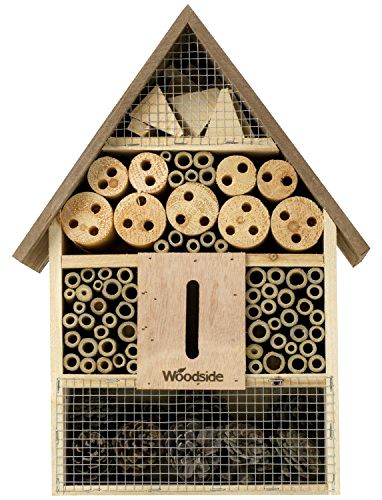
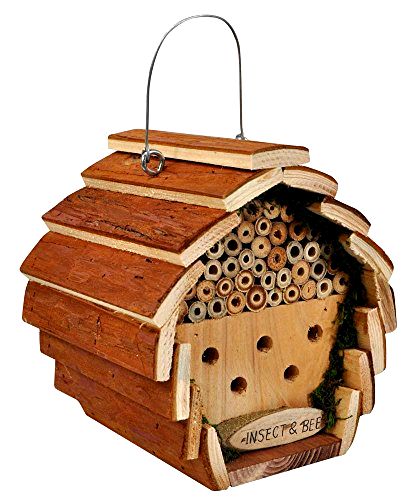

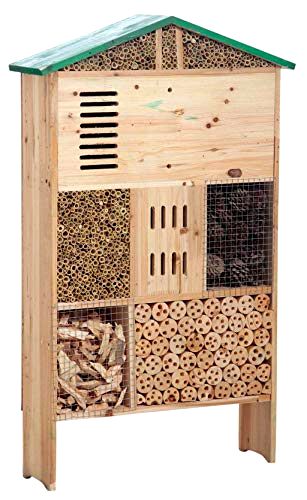
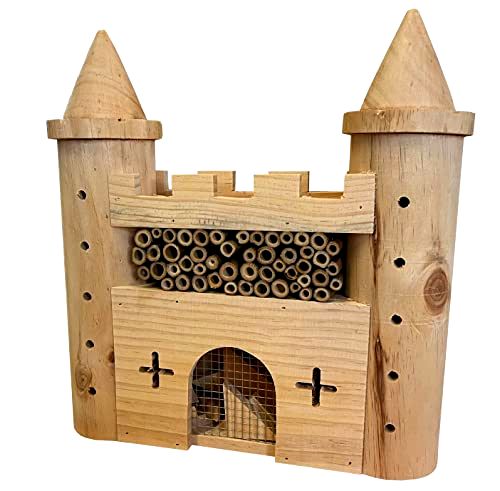

Share